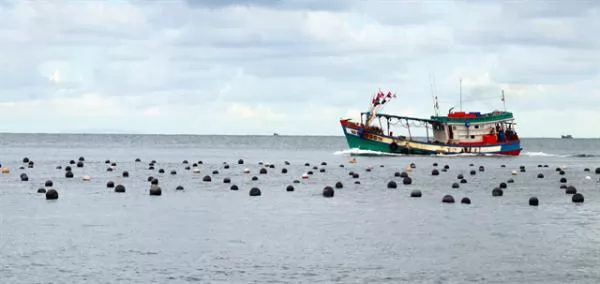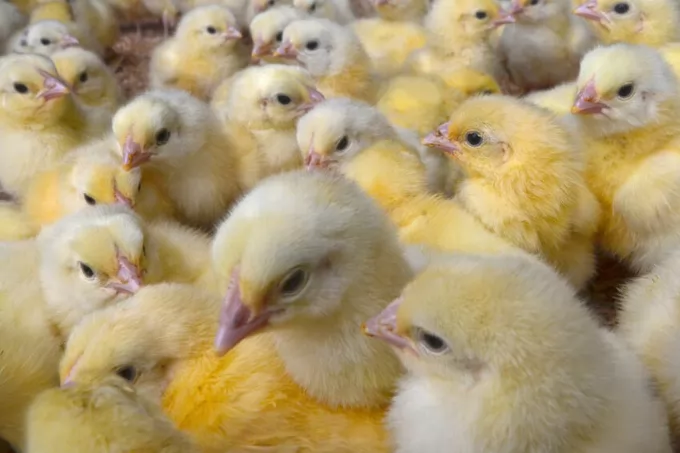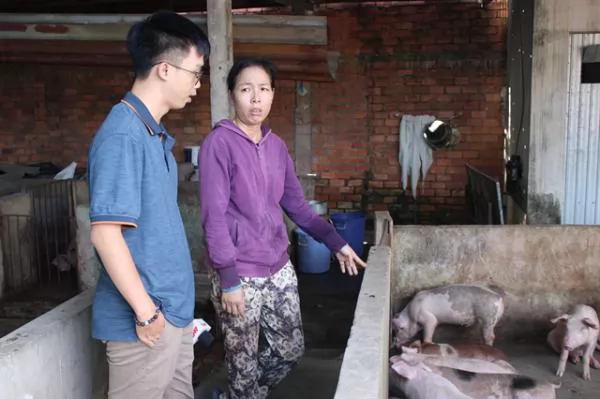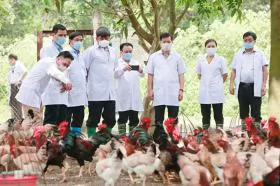Kiên Giang expands breeding of bivalve mollusks

A pearl oyster breeding area in Kiên Giang Province's Phú Quốc District. — VNA/VNS Photo Lê Huy Hải
KIÊN GIANG — The cultivation of bivalve mollusks in Kiên Giang Province’s coastal areas has developed rapidly in the last decade, improving farmers' incomes.
The Cửu Long (Mekong) Delta province has 22,700ha of bivalve mollusks compared to only 2,700ha in 2010, according to the province’s Department of Agriculture and Rural Development.
The bivalve mollusk output increased from more than 61,300 tonnes last year to 74,200 tonnes this year, the department estimated.
Farmers in the province breed various kinds of bivalve mollusks, mostly ark clam, blood cockle, green mussel and yellow clam.
Blood cockles are bred on a total area of 8,700ha, mostly in coastal mudflats, mangrove forests and shrimp ponds in An Biên, An Minh and Hòn Đất districts.
Ark clam, yellow clam and green mussel are bred on a total area of 7,000ha in Kiên Lương and Hòn Đất districts and Hà Tiên City.
The province also breeds other high value bivalve mollusks including Babylon snails and pearl oysters in small areas.
Pearl oysters are bred in Phú Quốc Island District for their pearls and other products to serve tourists who visit the island.
Phú Quốc is the first place in the delta to breed pearl oysters.
Quảng Trọng Thao, deputy director of the department, said that the breeding of bivalve mollusks in mangrove forests had potential to be combined with ecotourism services.
The cultivation of pearl oysters in combination with tourism services in Phú Quốc District had offered high economic value for farmers and had become the district’s tourism product, he said.
The province has allocated the management of hundreds of thousands of mangrove forests to local households to protect and exploit. These households have bred bivalve mollusks and earned dozens of million of đồng per hectare a year, according to the department.
However, the cultivation of bivalve mollusk species is facing the impact of climate change, disease and declining quantity of natural bivalve mollusk seeds.
With a coastline of more than 200 kilometres and 137 large and small islands, the province has great potential for marine aquaculture, including breeding bivalve mollusk species.
To develop sustainable cultivation, the province will rezone the cultivation of each bivalve mollusk species in suitable areas.
It will also regularly inspect the water quality of the bivalve mollusk breeding environment and monitor disease outbreaks, and provide farming techniques to help farmers solve problems.
More co-operatives and co-operative groups will be created to work with companies to develop value chains for bivalve mollusk cultivation.
To adapt to climate change, the province is also stepping up the application of advanced techniques in breeding.
The province is also developing the breeding of high - value bivalve mollusk species such as Babylon snail and pearl oysters and is seeking more export markets for them. — VNS
Maybe you are interested

Intensive farming and the risk of new pandemics
Intensive livestock farming could raise the risk of new pandemics, according to researchers.

Agricultural innovation key to capital's food security
HÀ NỘI — High-value specialty crops and livestock are being developed to meet the increasing consumption needs of domestic consumers, in line with the comparative advantage of each locality, but more needs to be done, Deputy Minister of Agriculture and Ru

HCM City to switch from pork production to pig breeding
HCM CITY — HCM City plans to move its pig farming industry away from breeding for pork and increase the number of pigs raised for breeding purposes in the next five years.





